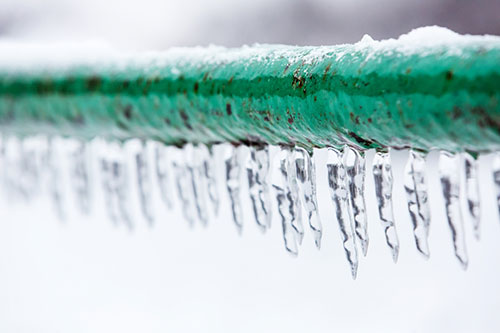You’ve learned how to prevent frozen pipes, plus some of the tell-tale signs that your pipes could be frozen. But what should you do if you still find a frozen pipe in your home’s plumbing system?
If you’ve discovered frozen pipes in your home there are several easy steps you can take to thaw them out. From the bathroom to the kitchen, here’s what you need to know about thawing out frozen pipes.
Finding a Frozen Water Pipe
First, you need to locate the section of the pipe that’s frozen. Once you suspect a frozen pipe, do the following:
- Turn off the faucet or shut off your home’s main water shutoff valve.
- Next, open the faucet that’s associated with the frozen pipe, even if you aren’t yet sure where exactly the blockage is located. Once the ice dam is thawed, water will flow out of the pipe, and water flow also helps melt ice faster.
- Once you know which faucet and pipe are frozen, locate the blockage. Follow the pipe from the faucet toward cold, unheated areas. Exterior walls and unheated crawl spaces are common culprits.
You might notice frost on the pipe or areas with slight bulges or breaks. These are sure signs that you’ve found the right spot.
Thawing a Frozen Pipe Behind a Wall
Hopefully, the frozen pipe hasn’t burst. If it has, that will require the help of a licensed plumber. If a pipe is frozen and located behind a wall, your best bet is to turn your home’s furnace up and then wait for the warmth to reach the pipe. You can also use an infrared lamp to help heat the section of wall where you think the pipe is frozen.
You may also have to cut out a piece of drywall to gain access to the frozen section of pipe. If that’s the case, the steps you take will be slightly different.
Thawing a Frozen Pipe That’s Exposed
Exposed pipes can be found in your bathroom or kitchen cabinets, and also outside (or via removing drywall, as mentioned above, if necessary). If you notice an exposed frozen pipe, try the following:
- Apply heat to the frozen pipe with a heating pad, blow dryer, towels soaked in hot water, or with a space heater. Continue to apply heat until water pressure is restored.
- Wrap heat tape around the frozen section of pipe. Heat tape is a wrap that has electrical heating elements within the material. Simply wrap it around the pipe and plug it into the wall. Heat wraps also include a thermostat, making them a great option for more permanent frozen pipe prevention.
- If the pipe is located inside a cabinet, keep the cabinet door open so that heat from the rest of the room can reach the pipe.

Protect Your Home With 2-10
Once your pipes are thawed and in proper working order, consider protecting your home and its appliances with an affordable Home Service Plan from 2-10 Home Buyers Warranty (2-10). Find out how a 2-10 Home Service Plan can protect you from financial surprises at home.









